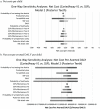An Economic Evaluation of a Comprehensive School-Based Caries Prevention Program
- PMID: 31009589
- PMCID: PMC6749793
- DOI: 10.1177/2380084419837587
An Economic Evaluation of a Comprehensive School-Based Caries Prevention Program
Abstract
Introduction: Current economic evaluations of school-based caries prevention programs (SCPPs) do not compare multiple types of SCPPs against each other and do not consider teeth beyond permanent first molars.
Objectives: To assess the cost-effectiveness of a comprehensive SCPP relative to an SCPP focused on delivering sealants for permanent first molars only and to a default of no SCPP. Based on a societal perspective, a simulation model was used that compared the health and cost impacts on 1) permanent first molars only and 2) all posterior teeth.
Methods: To calibrate the model, we used data from CariedAway, a comprehensive SCPP that used glass ionomer to prevent and arrest active decay among children. We then evaluated the incremental cost-effectiveness of implementing 3 alternate school-based approaches (comprehensive, sealant only, and no program) on only first molars and all posterior teeth. Probabilistic, 1-, and 2-way sensitivity analyses are included for robustness. Cost-effectiveness is assessed with a threshold of $54,639 per averted disability-adjusted life year (DALY).
Results: We first compared the 3 programs under the assumption of treating only first molars. This assessment indicated that CariedAway was less cost-effective than school-based sealant programs (SSPs): the resulting incremental cost-effectiveness ratio (ICER) for CariedAway versus SSPs was $283,455 per averted DALY. However, when the model was extended to include CariedAway's treatment of all posterior teeth, CariedAway was not only cost-effective but also cost-saving relative to SSPs (ICER, -$943,460.88 per averted DALY; net cost, -$261.45) and no SCPP (ICER, -$400,645.52 per averted DALY; net cost, -$239.77).
Conclusions: This study finds that economic evaluations assessing only cost and health impacts on permanent first molars may underestimate the cost-effectiveness of comprehensive SCPPs 1) preventing and arresting decay and 2) treating all teeth. Hence, there is an urgent need for economic evaluations of SCPPs to assess cost and health impacts across teeth beyond only permanent first molars.
Knowledge transfer statement: The results of this study can be used by policy makers to understand how to evaluate economic evaluations of school-based caries prevention programs and what factors to consider when deciding on what types of programs to implement.
Keywords: cost-benefit analysis; dental care for children; economics; evidence-based dentistry; preventive dentistry; school health services.
Conflict of interest statement
The authors declare no potential conflicts of interest with respect to the authorship and/or publication of this article.
Figures


Similar articles
-
[Caries prevention effectiveness of aresin based sealant and a glass ionomer sealants: a report of 5-year-follow-up].Zhonghua Kou Qiang Yi Xue Za Zhi. 2018 Jul 9;53(7):437-442. doi: 10.3760/cma.j.issn.1002-0098.2018.07.002. Zhonghua Kou Qiang Yi Xue Za Zhi. 2018. PMID: 29996359 Clinical Trial. Chinese.
-
The cost-utility of school-based first permanent molar sealants programs: a Markov model.BMC Oral Health. 2019 Dec 30;19(1):293. doi: 10.1186/s12903-019-0990-3. BMC Oral Health. 2019. PMID: 31888582 Free PMC article.
-
Four-year cost-utility analyses of sealed and nonsealed first permanent molars in Iowa Medicaid-enrolled children.J Public Health Dent. 2007 Fall;67(4):191-8. doi: 10.1111/j.1752-7325.2007.00025.x. J Public Health Dent. 2007. PMID: 18087989
-
Economic evaluation of dental sealants: A systematic literature review.Community Dent Oral Epidemiol. 2018 Feb;46(1):38-46. doi: 10.1111/cdoe.12326. Epub 2017 Sep 6. Community Dent Oral Epidemiol. 2018. PMID: 28876472
-
[Fissure sealing. A review].Fogorv Sz. 2008 Aug;101(4):137-46. Fogorv Sz. 2008. PMID: 19055129 Review. Hungarian.
Cited by
-
A Dental Response to the COVID-19 Pandemic-Safer Aerosol-Free Emergent (SAFER) Dentistry.Front Med (Lausanne). 2020 Aug 12;7:520. doi: 10.3389/fmed.2020.00520. eCollection 2020. Front Med (Lausanne). 2020. PMID: 32903453 Free PMC article.
-
Predicting Treatment Nonresponse in Hispanic/Latino Children Receiving Silver Diamine Fluoride for Caries Arrest: A Pilot Study Using Machine Learning.Front Oral Health. 2021 Jul 26;2:695759. doi: 10.3389/froh.2021.695759. eCollection 2021. Front Oral Health. 2021. PMID: 35048036 Free PMC article.
-
A Cost Analysis of an Outreach School-Based Dental Program: Teeth on Wheels.Children (Basel). 2021 Feb 18;8(2):154. doi: 10.3390/children8020154. Children (Basel). 2021. PMID: 33670541 Free PMC article.
-
Systematic review on cost-effectiveness analysis of school-based oral health promotion program.PLoS One. 2023 Apr 20;18(4):e0284518. doi: 10.1371/journal.pone.0284518. eCollection 2023. PLoS One. 2023. PMID: 37079535 Free PMC article.
-
Effect of Silver Diamine Fluoride on Caries Arrest and Prevention: The CariedAway School-Based Randomized Clinical Trial.JAMA Netw Open. 2023 Feb 1;6(2):e2255458. doi: 10.1001/jamanetworkopen.2022.55458. JAMA Netw Open. 2023. PMID: 36757696 Free PMC article. Clinical Trial.
References
-
- Akinlotan M, Chen B, Fontanilla TM, Chen A, Fan VY. 2018. Economic evaluation of dental sealants: a systematic literature review. Community Dent Oral Epidemiol. 46(1):38–46. - PubMed
-
- Bukhari OM. 2016. Longitudinal clinical outcomes and cost-effectiveness evaluation of a comprehensive school-based dental prevention program—ForsythKids. Doctoral dissertation. Boston (MA): Harvard School of Dental Medicine.
-
- Community Preventive Services Task Force. 2016. Guide to community preventive services. Preventing dental caries: School-based dental sealant delivery programs. Washington (DC): US Department of Health and Human Services.
-
- Gooch BF, Griffin SO, Gray SK, Kohn WG, Rozier RG, Siegal M, Fontana M, Brunson D, Carter N, Curtis DK, et al.; Centers for Disease Control and Prevention. 2009. Preventing dental caries through school-based sealant programs: updated recommendations and reviews of evidence. J Am Dent Assoc. 140(11):1356–1365. - PubMed
Publication types
MeSH terms
Substances
Grants and funding
LinkOut - more resources
Full Text Sources
Medical

